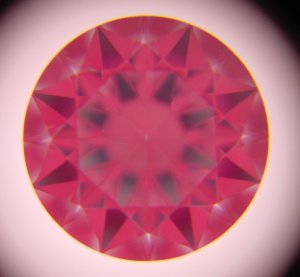You are using an out of date browser. It may not display this or other websites correctly.
You should upgrade or use an alternative browser.
You should upgrade or use an alternative browser.
My attempt to take my own Ideal-scope Image
- Thread starter greengook
- Start date
- Status
- Not open for further replies. Please create a new topic or request for this thread to be opened.
wonka27
Brilliant_Rock
- Joined
- Jun 22, 2004
- Messages
- 628
- Joined
- Aug 29, 2003
- Messages
- 15,808
This is one interesting Q. The stone does not look H&A-ish and gets set into the BIC range by HCA (score 1.3, Vg-Ex-Ex-Ex) - and not too many do around here... Also, few get "excellent" spread among tipical H&A.
I hope you will get the complete Sarin to run a model of this stone and see if Diam Calc approximates well what you see, but in the meantime, I would attempt to explain the look of the arrows by two factors: the length of upper girdle facets (since I see those reflectors between the arrows) and the pavilion height which is a bit less than one would expect from a tipical H&A piece (this could explain why the arrow shafts start forming away from the center of the stone, rezulting in shorter arrows). I could not find a simmilar stone with complete list of brilliance tests, but you could take a look at the tutorial pages about how arrows are formed (LINK) to see where my guess comes from. The other source is GOG's page on minor facets (LINK).
This stone seems to be one good example that those arrows are not needed to obtain top light return, either in direct light conditions or otherwise

What do those harts look like if at all ? If you do not have a H&A viewer at hand, the Iscope could do the trick if you allow the stone to get light not from behind but from between the Iscope and camera (lateral lighting, of course).

I hope you will get the complete Sarin to run a model of this stone and see if Diam Calc approximates well what you see, but in the meantime, I would attempt to explain the look of the arrows by two factors: the length of upper girdle facets (since I see those reflectors between the arrows) and the pavilion height which is a bit less than one would expect from a tipical H&A piece (this could explain why the arrow shafts start forming away from the center of the stone, rezulting in shorter arrows). I could not find a simmilar stone with complete list of brilliance tests, but you could take a look at the tutorial pages about how arrows are formed (LINK) to see where my guess comes from. The other source is GOG's page on minor facets (LINK).
This stone seems to be one good example that those arrows are not needed to obtain top light return, either in direct light conditions or otherwise

What do those harts look like if at all ? If you do not have a H&A viewer at hand, the Iscope could do the trick if you allow the stone to get light not from behind but from between the Iscope and camera (lateral lighting, of course).

- Joined
- Aug 15, 2000
- Messages
- 18,897
wonka27
Brilliant_Rock
- Joined
- Jun 22, 2004
- Messages
- 628
- Joined
- Aug 15, 2000
- Messages
- 18,897
----------------
On 8/10/2004 4:10:53 PM wonka27 wrote:
Seriously?----------------
Yes

The first one is better, and is pretty much what you see.
Mara
Super_Ideal_Rock
- Joined
- Oct 30, 2002
- Messages
- 31,003
- Status
- Not open for further replies. Please create a new topic or request for this thread to be opened.
Share:
Past, Present, Future: The Meaning of Three-Stone Engagement Rings
Past, Present, Future: The Meaning of Three-Stone Engagement Rings - 04/14





300x240.png)